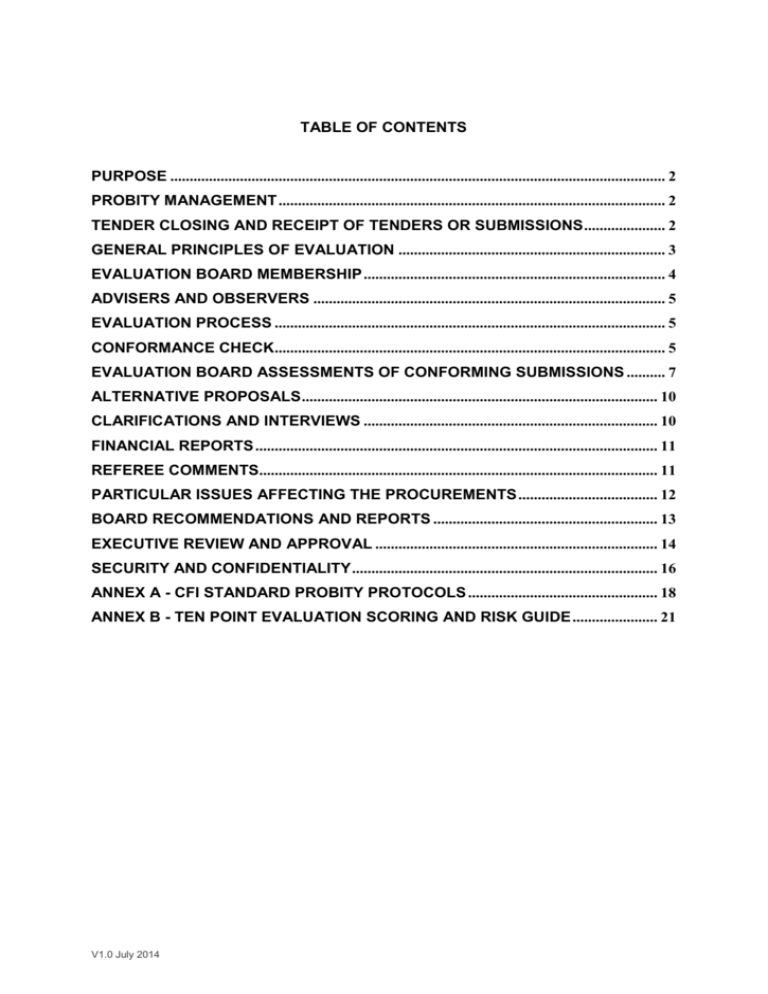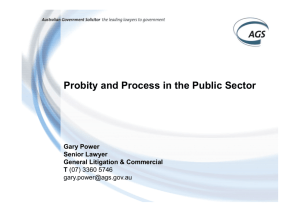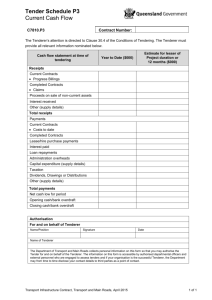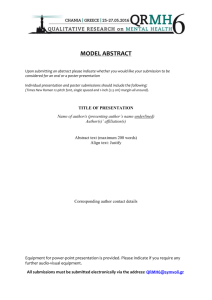Evaluation Protocol - Department of Defence
advertisement

TABLE OF CONTENTS PURPOSE ................................................................................................................................ 2 PROBITY MANAGEMENT .................................................................................................... 2 TENDER CLOSING AND RECEIPT OF TENDERS OR SUBMISSIONS ..................... 2 GENERAL PRINCIPLES OF EVALUATION ..................................................................... 3 EVALUATION BOARD MEMBERSHIP .............................................................................. 4 ADVISERS AND OBSERVERS ........................................................................................... 5 EVALUATION PROCESS ..................................................................................................... 5 CONFORMANCE CHECK..................................................................................................... 5 EVALUATION BOARD ASSESSMENTS OF CONFORMING SUBMISSIONS .......... 7 ALTERNATIVE PROPOSALS ............................................................................................ 10 CLARIFICATIONS AND INTERVIEWS ............................................................................ 10 FINANCIAL REPORTS ........................................................................................................ 11 REFEREE COMMENTS....................................................................................................... 11 PARTICULAR ISSUES AFFECTING THE PROCUREMENTS .................................... 12 BOARD RECOMMENDATIONS AND REPORTS .......................................................... 13 EXECUTIVE REVIEW AND APPROVAL ......................................................................... 14 SECURITY AND CONFIDENTIALITY ............................................................................... 16 ANNEX A - CFI STANDARD PROBITY PROTOCOLS ................................................. 18 ANNEX B - TEN POINT EVALUATION SCORING AND RISK GUIDE ...................... 21 V1.0 July 2014 OFFICAL-USE-ONLY PAGE 2 PURPOSE 1. This Evaluation Protocol details the evaluation strategies and methodologies for the procurement of services by Capital Facilities and Infrastructure (CFI) Branch. PROBITY MANAGEMENT 2. All procurement activities will adhere to and meet the requirements of the relevant Financial Regulations, Commonwealth Procurement Rules (‘CPRs’), Accountable Authority Instructions, Defence Procurement Policy Manual and relevant Defence Estate Quality Management System (‘DEQMS’) policies and procedures with respect to receiving, handling and evaluating submissions. 3. As soon as possible following engagement of the Probity Adviser (if any) the Project Director/Officer and Probity Adviser will agree and document a probity plan and a set of probity protocols that will apply to each and every procurement activity covered by this Evaluation Protocol. These probity protocols will be distributed to each member of each Evaluation Board prior to, or together with, the distribution of the submissions for individual evaluation. Where this is not possible due to late engagement of a Probity Adviser, the probity protocols will be distributed at the earliest available opportunity. Where no probity adviser is engaged, the CFI Standard Probity Protocols at Annex A to this Evaluation Protocol will be used. TENDER CLOSING AND RECEIPT OF TENDERS OR SUBMISSIONS 4. For each procurement process conducted, all Applicants (in the case of an Invitation to Register Interest – ‘ITR’) or Tenderers (in the case of a Request for Proposal/Tender – ‘RFT’) will be advised, via the request documentation, of the closing time and date for lodging a submission in response to the ITR or an RFT submission (‘Tender’) (as applicable). 5. After the closing time and date, submissions will be opened by independent witnesses who will have no involvement in the evaluation of the submissions, and will be receipted in accordance with Capital Facilities and Infrastructure (‘CFI’) Branch policy on receipting of submissions, which is located on ‘DEQMS’. 6. Submissions received will be distributed to the Chair of each Evaluation Board to enable the Chair (or his or her delegate) to conduct a conformance check. V 1.0 July 2014 OFFICAL-USE-ONLY PAGE 3 7. Late submissions will not be admitted to evaluation unless the circumstances are such that admission of the submission is consistent with the conditions permitted by the CPRs. 8. Late submissions will be returned to the Applicant or Tenderer unopened, unless it is necessary to open a submission to identify a return address or to determine which ITR or RFT the submission relates, in which case the Applicant or Tenderer should be advised that the submission has been rejected due to lateness and the reason the submission was opened. 9. Any uncertainty regarding the lateness of a submission will be referred by the Chair to the Probity Adviser, where one has been appointed, or Director of Capital Facilities Processes and Compliance (‘DCFPC’) where no Probity Adviser has been appointed. 10. After conducting a conformance check, the Chair will distribute copies of submissions found at that time to be conforming to members of the Evaluation Board. The Chair will also cause to be distributed to members of the Evaluation Board a copy of the Evaluation Protocol, the applicable probity protocols, the Ten Point Evaluation and Risk Scoring Guide and scoring sheets. In appropriate cases, this may be achieved by use of the Tender Evaluation Pack (template available on DEQMS). 11. In the event of any discrepancies between copies (hard or soft) of the submission, the submission marked "Original" will prevail. 12. Where no copy of a submission is marked “Original”, the Chair will randomly select one copy to be considered the “Original” in the event of a discrepancy. GENERAL PRINCIPLES OF EVALUATION 13. Each evaluation will conform to the requirements of this Evaluation Protocol unless there has been prior written approval of an amendment to this protocol by the Delegate. Amendments should not be made to the Evaluation Protocol after the closing time and date of the relevant procurement activity except with advice from the Probity Adviser, where one has been appointed, or DCFPC where no Probity Adviser has been appointed. V 1.0 July 2014 OFFICAL-USE-ONLY PAGE 4 14. If deviation from the protocol is necessary for any reason, all deviations will be documented and justified in the resulting Evaluation Board Report for consideration by the approving authorities. Deviations will also be referred to the Probity Adviser, where one has been appointed, or DCFPC where no Probity Adviser has been appointed, for advice and best management to ensure selection recommendations remain defensible and transparent. 15. Each evaluation will be completed expediently. 16. Each Evaluation Board Member will review the submissions independently, without reference to any other person, including referees, and record their commentary and initial scoring against the applicable evaluation criteria. In scoring submissions each Evaluation Board Member will have regard to the agreed Ten Point Evaluation and Risk Scoring Guide provided in the Tender Evaluation Pack. 17. Once an Evaluation Board is convened, evaluation will be conducted in a collaborative manner to attempt to achieve a consensus and Board agreed recommendation. Where the Board cannot achieve consensus it will be recorded in the applicable Evaluation Board Report. 18. In completing the evaluation, the Board will satisfy itself that the recommendation of the shortlist to be invited to Tender following the conduct of the ITR, or of a preferred Tenderer/Contract Award following the conduct of a RFT, will result in the achievement of value for money to the Commonwealth. 19. All members of the Evaluation Board will sign the Evaluation Board Report prior to its submission to the Delegate. Dissenting views are covered in the section below titled “Board Recommendations and Reports”. EVALUATION BOARD MEMBERSHIP 20. The respective Evaluation Boards will be convened after each member of that Evaluation Board has been given access to the submissions and had sufficient time to finalise their individual assessments of the submissions. 21. The composition of each Evaluation Board is confirmed in the applicable annex to the PDDP for the approved project. 22. At the commencement of the Evaluation Board, all members of the Evaluation Board will be asked to confirm that they had sufficient time to assess the V 1.0 July 2014 OFFICAL-USE-ONLY PAGE 5 submissions, and that they have no undeclared matters that may constitute a conflict of interest in relation to the submissions or any of the Applicants or Tenderers. Each member of the Evaluation Board will be required to complete and sign a Conflict of Interest declaration. ADVISERS AND OBSERVERS 23. If a Probity Adviser has been engaged, the Probity Adviser should attend Evaluation Board meetings in order to discharge their responsibilities. The Probity Adviser is not a member of the Evaluation Board. Where a Probity Adviser has not been engaged, DCFPC must be consulted. 24. The applicable annex of the PDDP for the approved project describes the identity and scope of any evaluation specialist resources that may be sought to assist the Evaluation Board Members understand or interpret aspects of submissions. 25. With the Chair’s consent, others may attend Evaluation Board meetings as Observers. CFI Branch staff may only attend as Observers for training and development purposes. 26. The justification for the attendance of any Observers should be recorded in the Evaluation Board Report. Observers are not members of the Evaluation Board. 27. Any attendee at the Evaluation Board who is not an employee of the Department of Defence or a member of the ADF will be required to complete and sign a Confidentiality Deed. EVALUATION PROCESS 28. The evaluation will comprise three distinct stages: a. Conformance Check by the Chair or his/her delegate; b. Individual Board Member Assessments of conforming submissions; c. Evaluation Board Assessments of conforming submissions. CONFORMANCE CHECK 29. Prior to distributing submissions to the Board, the Chair will conduct a conformance check to ensure that each submission received complies with conformance requirements. The Chair should be satisfied that each submission: a. V 1.0 July 2014 has, subject to the CPRs, been submitted by the closing time and date; OFFICAL-USE-ONLY PAGE 6 b. meets all minimum form and content requirements; and c. meets all conditions of participation. 30. Only those submissions that satisfy the conformance requirements will be admitted to evaluation, unless the failure to satisfy a minimum form and content requirement falls within the allowable discretion provided in the relevant request document. The exercise of any discretion to allow the correction of a failure to satisfy a minimum form and content requirement in a submission must be conducted equitably. 31. Where the Chair or his/her delegate finds that there is doubt over conformance of any submission, it will be referred to either the Probity Adviser, if one has been appointed, or to the DCFPC, where a Probity Adviser has not been engaged. In consultation with the Probity Adviser or DCFPC, as applicable, the Chair or his/her delegate will form a view as to conformance or otherwise of the submission and record this for tabling at the Board meeting. 32. The Chair is not required to conduct a detailed check to determine whether submissions attempt to depart from or qualify the contract (where this is a minimum form and content requirement) during this stage of evaluation. However, if during any stage of evaluation, a Board member suspects a submission indicates a departure from or qualification to the contract, the Chair will determine conformance, acting on legal and probity advice, as appropriate. INDIVIDUAL BOARD MEMBER ASSESSMENTS 33. The Evaluation Criteria and Weightings that apply to each stage of each procurement must be annexed to the relevant PDDP and must be consistent with the request documentation. 34. The Ten Point Evaluation and Risk Scoring Guide at Annex B applies to each Evaluation (excluding Legal Services). 35. Once the initial conformance check has been completed, those unaffected submissions will be distributed to the remaining Board members (along with a copy of this Evaluation Protocol and the probity guidance) for the commencement of individual Board member detailed assessments. If submissions are to be posted to external Board members, the Chair will ensure that the submissions are posted in a V 1.0 July 2014 OFFICAL-USE-ONLY PAGE 7 manner that complies with any applicable Defence security policy. Individual Board members will score each submission by reference to the weighted evaluation criteria set out in the applicable Annex to the PDDP and the Ten-Point Evaluation and Risk Scoring Guide at Annex B of this Evaluation Protocol, using whole number scores only. Individual Board members will bring notes on the assessments to the Evaluation Board to refer to during the Board Detailed Assessment of Submissions. 36. If it becomes apparent to any Board member that the content of a submission may be otherwise non-conforming, this will be referred to the Chair who will follow the same process outlined in the “Conformance Check” section above for managing conformance requirements. EVALUATION BOARD ASSESSMENTS OF CONFORMING SUBMISSIONS 37. After the completion of Individual Board Member Assessments, the Evaluation Board will meet to discuss the submissions. This stage of evaluation comprises three stages: a. Board Detailed Assessment of Submissions b. Board Comparative Assessment of Submissions; c. Shortlisting (for ITR stage) or Value for Money (for RFT stage). 38. The Probity Adviser (where one is appointed) will provide a probity brief at the commencement of each Board to all Board members on their responsibilities with respect to Commonwealth procurements. 39. Where no Probity Adviser has been appointed, the Chair will ensure that a probity briefing taking into account Annex A of this Evaluation Protocol is conducted. a. Board Detailed Assessment of Submissions 40. Each submission will be discussed in its entirety across all evaluation criteria weighted Schedule responses, before moving onto the next submission. Board members will address the particular strengths and weaknesses of the submission, having regard to the evaluation criteria and the Ten-Point Evaluation and Risk Scoring Guide provided in the Tender Evaluation Pack. Comparisons of submissions do not occur during this stage. 41. The nominated member of the Evaluation Board, in addition to contributing to discussion with their individual scores, will act as Board Secretary and record the V 1.0 July 2014 OFFICAL-USE-ONLY PAGE 8 discussion for use in developing the Board’s detailed comments as part of the Evaluation Board Report, and also for use in the debrief of Applicants or Tenderers. If, with the consent of the Chair, a scribe is engaged, the scribe will record the Board deliberations but must not contribute to the discussions in any way. 42. On completion of the Detailed Assessment of Submissions against the weighted evaluation criteria, the Board will agree an initial Board Agreed Score for each submission against each weighted evaluation criterion, using whole number scores only. After completing the detailed assessment of each submission in the manner described in this section, the Board will move to the Comparative Assessment stage. b. Board Comparative Assessment of Submissions 43. At the commencement of the Comparative Assessment of submissions, the Board may determine that a submission, based on the outcome of the Detailed Assessment stage, is clearly uncompetitive, in which case the submission may be set aside from further evaluation and not assessed during the Comparative Assessment stage. The Board must record for inclusion in the Evaluation Board Report the reason(s) the submission was considered uncompetitive. 44. During the Comparative Assessment, the Board will examine the initial Board Agreed Score awarded to the weighted evaluation criterion Schedule responses in comparison to the other submissions received to either confirm or adjust the initial Board Agreed Scores so as to determine an agreed ranking of submissions. In assessing each submission in relation to the others, the Board will ensure each submission is assessed on its demonstrated merit (by Schedule) and without reference to total weighted scores or rankings, and then is compared to other submissions to reduce the likelihood of any relative imbalance between initial Board Agreed Scores. Half scores may be used at this point if considered necessary by the Board to differentiate between submissions of similar, but not equal, merit. The Board Secretary (or scribe, if appointed) will record the discussions and comments comparing and contrasting the various submissions’ Schedule responses for reporting in the relevant Evaluation Board Report. 45. After having finalised the Board Agreed Scores and determined rankings of each submission on technical merit, the Board will proceed to Shortlisting, if V 1.0 July 2014 OFFICAL-USE-ONLY PAGE 9 conducting an ITR process, or a Value for Money (‘VFM’) assessment, if conducting an RFT process. c. Shortlisting 46. For those procurements approved for two stage tendering process, the Board will recommend a shortlist of up to 5 entities from the ITR stage to be invited to submit a Tender in response to an RFT issued by the Commonwealth. The shortlist should not recommend a lower ranked submission ahead of a higher ranked submission unless, as a result of an adverse clarification response, interview, referee report or other identified risk, the Board concludes the higher ranked submission is not suitable. The Board Secretary shall record the discussions and comments against the shortlisting assessment for reporting in the Evaluation Board Report. Value for Money 47. At the commencement of the VFM assessment of Tenders, the Board may determine that a submission, based on the outcome of the Detailed Assessment of Submissions and the Comparative Assessments stages, is clearly uncompetitive, in which case the submission may be set aside from further evaluation and not assessed against VFM. The Board must record for inclusion in the Evaluation Board Report the reason(s) the submission was considered uncompetitive. 48. For the RFT stage, the VFM assessment involves consideration by the Board of the Contract Price and, as applicable, the Tenderer’s Commercial Position (including any Building Code 2013 response) and any other non weighted evaluation criteria, together with any risks associated with the submission (which may arise, for example, from clarification responses, interviews or referee reports), additional value and whole of life implications. The Board will then agree a preliminary recommendation as to either a preferred Tenderer list (where negotiations are required) or a contract award (where no negotiations are required to accept the Tender). The Board Secretary shall record the discussions and comments against the VFM assessment for reporting in the relevant Evaluation Board Report. V 1.0 July 2014 OFFICAL-USE-ONLY PAGE 10 ALTERNATIVE PROPOSALS 49. Each Tenderer will be advised that Tenderers must provide a conforming Tender before alternatives can be considered. 50. All alternative proposals will be considered where submitted with a conforming Tender. 51. Alternative proposals will not be scored, but will be given a subjective evaluation based on VFM following the VFM assessment for all competitive conforming Tender(s). In evaluating alternatives, consideration should be given as to whether the proposal offers additional benefit to Defence such as reduced risk, more product, financial savings or early completion where time is critical. If there is any uncertainty regarding how alternative proposals are to be considered, advice will be sought from the Probity Adviser, where a Probity Adviser has been engaged, or from DCFPC where no Probity Adviser has been appointed. 52. Advice must be sought from DCFPC for any alternative proposals proposing changes to standard terms and conditions of the Contract in Part 5 of the RFT, or to the terms of any current Deed of Standing Offer for panel arrangements. CLARIFICATIONS AND INTERVIEWS 53. During any stage of evaluation the Board may seek, in writing, clarification of information provided by Applicants or Tenderers in their submissions. Clarification should be sought in writing, with the input of the Probity Adviser if possible. Clarification must not be sought by individual Board members unless at the direction of the Chair. 54. If a response goes beyond the scope of the clarification request by attempting to introduce materially new information not included in the submitted Tender which, if taken into account, could unfairly enhance the Tender, the part of the response attempting to introduce such information will not be considered. 55. Any clarifications should be addressed during the evaluation period. 56. If required, and as agreed by the Board, interviews or post-tender correspondence with Applicants or Tenderers may be undertaken during the evaluation period. The purpose may be to clarify any issues raised by the Board in appreciating the submission or to interview key personnel nominated for the project. V 1.0 July 2014 OFFICAL-USE-ONLY PAGE 11 FINANCIAL REPORTS 57. In its absolute discretion, the Board may request and obtain a financial report from a Financial Risk Analysis company to confirm the financial standing and capacity of one or more Applicants or Tenderers. Where a financial report is obtained it will be included as an attachment to the relevant Board Report and any adverse findings must be summarised in the Board Report. REFEREE COMMENTS 58. In its absolute discretion, the Board may seek referee comments for Applicant or Tenderer entities, or their personnel, in respect of those submissions that have been deemed competitive to confirm information provided in the submissions or to identify risks. 59. Referee comments may be sought from referees other than those nominated in submissions, provided doing so is not inconsistent with the evaluation process detailed in the request documentation. 60. Records of any referee comments will be included in the relevant Evaluation Board Report. 61. Where the Board determines a need for referee reports (for example, for all competitive submissions, or to distinguish between two or more similarly ranked submissions) the Board will agree on a set of questions materially consistent for all referees, unless there is a specific issue affecting a particular submission. 62. The Chair or his/her delegate will then: a. meet with the referees (via teleconference if appropriate) in the company of at least one other Board member to ask the agreed questions and record the answers for consideration by the Board; or b. ask the agreed questions of the referee alone, provided the referee has agreed to sign a record of the conversation to verify the accuracy of the report before it is provided to the other Board members; or c. ask the referee for a written report, to be provided to all Board members for consideration; or d. seek written referee reports and provide them to the Delegate for his or her consideration, without those reports being considered by the Board. V 1.0 July 2014 OFFICAL-USE-ONLY PAGE 12 63. Unless authorised by the Chair to do so, individual Board members must not seek referee comments during the evaluation process. PARTICULAR ISSUES AFFECTING THE PROCUREMENTS Building Code 2013 Compliance 64. For those procurements to which the Building Code 2013 applies, in order to demonstrate compliance, Applicants and Tenderers must, as a minimum form and content requirement, complete and attach the relevant Building Code 2013 Schedule. The components of the Building Code 2013 Schedule include a signed Undertaking of Compliance, Quick Questionnaire and information requested at Item C of the Schedule. The Chair will distribute the completed Questionnaire for each ITR (and RFT where there are any amendments to the ITR or where a single stage procurement method is used) to DCFPC and possibly the Department of Employment for Building Code 2013 compliance review. 65. The Board will conduct a qualitative assessment of the information provided by the Applicants or Tenderers at Item C of the Building Code 2013 Schedule, which may be taken into consideration at the Shortlisting/VFM stage. 66. Applicants who are found to be non-compliant with the Building Code 2013, as advised by DCFPC or the Department of Employment, at the time of lodging their Registration of Interest, are not eligible to be invited to submit a Tender. Where noncompliance is identified during the Registration of Interest or Tender evaluation period, those submissions will be excluded from further consideration. Federal Occupational Health and Safety Commissioner – RFT Stage 67. Where the procurement is within the scope of the Federal Occupational Health and Safety Commissioner Accreditation Scheme: a. at the conclusion of evaluation, the Board must satisfy itself that the recommended Tenderer is either accredited under the Federal Occupational Health and Safety Accreditation scheme, or has reasonable prospects of being accredited under that scheme prior to a contract being executed; and V 1.0 July 2014 OFFICAL-USE-ONLY PAGE 13 b. as part of the Contract Approval process, the Office of the Federal Occupation Health and Safety Commissioner Accreditation Scheme will be advised of the proposed Contract award. Outstanding Employee Entitlements and Judgements 68. Applicants and Tenderers may be asked to confirm they have no judicial decisions against them relating to employee entitlements (not including decisions under appeal) at the time of submission. In accordance with the CPRs, the Commonwealth must not enter into contracts with Tenderers who have had a judicial decision against them (not including decisions under appeal) relating to employee entitlements and who have not satisfied any resulting order. Indigenous Opportunities 69. For those procurements to which the Indigenous Opportunity Plan (‘IOP’) applies, the Board must, at the conclusion of evaluation, satisfy itself that the recommended Tenderer has a current and approved Indigenous Training Employment Supplier (‘ITES’) Plan, or has reasonable prospects of obtaining approval of its ITES Plan in accordance with the IOP prior to a contract being executed. BOARD RECOMMENDATIONS AND REPORTS 70. In the case of any procurement being tendered via a two stage process, the Board will produce a final agreed ranking of Applicants (only ranking those Applicants who are Building Code 2013 compliant for procurements where the Building Code 2013 applies) and a recommendation to the Delegate on which Applicants should be invited to submit a Tender, balancing the objective of encouraging competition while having due regard to the costs of tendering to industry. The shortlist should be restricted to those Applicants who have a genuine prospect of succeeding at the RFT stage, as demonstrated by their ITR submission. 71. In the case of a RFT, the Board will ensure the final recommendation for a preferred Tenderer(s) or for contract award is based on best VFM. In determining the relative VFM of each submission, the Board shall consider the technical merit (as V 1.0 July 2014 OFFICAL-USE-ONLY PAGE 14 reflected by the total weighted score), the Contract Price and, as applicable, the Tenderer’s Commercial Position together with any risks associated with the submission (which may arise, for example, from clarification responses, interviews or referee reports), additional value and whole of life implications, and any alternative proposal offered. 72. The evaluation process will result in a full report for consideration by the Delegate, with justification for: a. in the case of an ITR process, the recommended shortlist (up to five); or b. in the case of a RFT process, either: (1) the recommended preferred Tenderer(s) (where negotiations are required); or (2) the recommended contract award (where no negotiations are required to accept the Tender offer) in accordance with this Evaluation Protocol. 73. The Board may recommend subsequent preferred Tenderers as also offering VFM and suitable to award a contract to if, for any reason, a contract is not entered into with the first preferred Tenderer. All Tenderers not offering VFM will be recommended as ‘declined’. 74. The Board will formally agree to the record of the evaluation process by individually signing the Evaluation Board Report. If individual members do not agree with the Board recommendation they are able to provide a dissenting report to the Delegate. 75. The final Evaluation Board Report submitted for Executive Review and Approval must be sufficiently detailed to satisfy all governance requirements of defensibility. 76. Where a Probity Adviser has been engaged, a Probity Report will be completed by the Probity Adviser and is required to be attached to the Evaluation Board Report. EXECUTIVE REVIEW AND APPROVAL 77. The purpose of the Executive Review (by DCFPC) and Executive Approval (by the Delegate) is to certify that the outcomes of the Evaluation Board Report meet transparency and accountability requirements and confirm that the recommendation made is suitably justified in terms of VFM and probity. Executive Review and V 1.0 July 2014 OFFICAL-USE-ONLY PAGE 15 Executive Approval also ensure that the appropriate process for awarding preferred Tenderer status and/or awarding a contract is followed. Executive Review does not duplicate the role of Probity Adviser; rather it is the final gateway prior to the Delegate making a decision whether to award preferred Tenderer status and enter negotiations, or to accept a Tender and enter into a contract without negotiations, as appropriate. 78. The Evaluation Board Report must be subject to Executive Review and Executive Approval. If negotiations are required, the Negotiation Plan must also be subject to Executive Review and Executive Approval at this time. If negotiations are not required, a ‘Contract Approval Financial Submission’ will be provided with the Evaluation Board Report for Executive Review and Approval at this time. 79. Following Executive Approval of the Evaluation Board Report and any other relevant documents, the Chair or his or her delegate will advise the preferred Tenderer of its preferred status. 80. Where there are no negotiation issues, the Tender will be accepted and a contract awarded. 81. Where negotiation issues are identified, the Tenderer will be notified that it is the preferred Tenderer for the purpose of contract negotiations and the Chair will schedule a time for contract negotiation. 82. Once Executive Approval has been obtained, Contract Approval may be sought from an appropriate Delegate in accordance with the CFI Interim Business Rule on Financial Delegations. Once Financial Approval has been obtained, the Chair can inform the successful Tenderer and execute the contract. 83. The Chair will then notify unsuccessful Applicants and Tenderers in writing and offer to conduct a verbal debriefing. Successful Applicants and Tenderers will also be offered a verbal debriefing. 84. The purpose of a debriefing is to assist the Applicant or Tenderer improve the quality of their future submissions. Debriefings should focus on the strengths and weaknesses of the submission, based on the commentary recorded in the Evaluation Report, but without reference to material provided by, or commentary recorded for, other Applicants or Tenderers. The name of the successful Tenderer may be provided. V 1.0 July 2014 OFFICAL-USE-ONLY PAGE 16 SECURITY AND CONFIDENTIALITY 85. The Chair of the Evaluation Board will be responsible for the future security of submissions and their proper filing on the Commonwealth record until the time for archiving or disposal. The original submissions will be retained for the record and archiving. The Chair will be responsible for the destruction and disposal of copies provided to the Commonwealth by Applicants and Tenderers. 86. All deliberations of the Evaluation Boards are “commercial-in-confidence” and will be treated accordingly. V 1.0 July 2014 OFFICAL-USE-ONLY PAGE 17 ANNEXES: A CFI Standard Probity Protocols B Ten Point Evaluation and Risk Scoring Guide V 1.0 July 2014 ANNEX A TO EVALUATION PROTOCOL ANNEX A - CFI STANDARD PROBITY PROTOCOLS Purpose of the Briefing It is important that any action taken or decision made, by any Defence personnel (which include personnel on Contract to Defence), is taken or made on a foundation of compliance with probity principles. In short, any action or decision should be tested against the applicable probity principles, and tested before it is taken or made. The following are the core probity principles and are to be briefed to staff undertaking procurement activities for low risk/low cost projects. Probity Principles Confidentiality and Security Tenderers will supply significant amounts of information they will consider confidential, commercial and sensitive and as a result will not want it to fall into the hands of their competitors or to be made public. Accordingly it is essential that you secure all relevant documentation and information from any unauthorised access (physical and electronic) and confine all discussions regarding tenderers and the tender submission content to necessary evaluation discussions. The Board must apply a strict “need to know” basis framework to the Tender Evaluation process. If you leave the tender room during the course of an evaluation always ensure the room is locked. Do not leave tender submissions, evaluation narrative or scoring outcomes on your desk unattended. Do not discuss any aspects of the evaluation outside of the tender room – i.e over lunch or in a public space. Do not mention details of the evaluation to other members of the Branch/Division or outside of the working environment. Ensure that your area within Objective is secure and has only project relevant access allowed. Conflicts of Interest If you have any of the following: personal association with any Tender; personal association with any employee or consultant connected to any tenderer; or; V 1.0 July 2014 ANNEX A TO EVALUATION PROTOCOL if your personal circumstances or the circumstances of any relative will be detrimentally or advantageously affected by any outcome in the process in which you have an input or decision making role; If you have been offered an opportunity of possible or certain employment with any tenderer. This can be recently or in the past. They may represent an actual conflict of interest or create the environment of a perceived conflict of interest and the circumstances must be disclosed. Even if you personally don’t believe that there is a conflict of interest these circumstances to an outside observer could be misconstrued as a probity issue and must be disclosed and recorded within Evaluation records. In giving this Probity Briefing ask the Chairperson if there are any conflicts of interest he/she is aware that exist for that Tender Evaluation. These may not be immediately apparent until the Board members are given access to the Tender submissions and are able to view the nominated key personnel. Advise accordingly and ensure that the result of that discussion is recorded on the Tender Evaluation Board Report. Contact with Tenderers Avoid contact with any Tenderers beyond any normal day to day contact in relation to existing projects. Do not enter into conversations with Tenderers about the status of ongoing tenders. Remind them of the formal contact structure that will listed within your Conditions of Tender. Report to the tender Evaluation Chairperson any unusual contact that relates directly to the Tender being evaluated. Media If you get any queries from the media on any procurement activity refer that request to the Tender Evaluation Chairperson immediately. Gifts and Hospitality Do not seek or accept the offer of any gifts, hospitality or any other benefits from any tenderers. Immediately notify the Tender Evaluation Chairperson if any of these are offered by any Tenderer. If you receive gifts as part of the Tender lodgement (pens, promotional material etc) immediately register within the Branch Register and return to the company. V 1.0 July 2014 ANNEX A TO EVALUATION PROTOCOL Offers of Employment If prior to the completion of the procurement process you are approached by any Tenderer in connection with an offer of employment you must immediately inform the Tender Evaluation Chairperson. This will enable formal probity advice to be sought and steps to be put in place to protect the process and the person from being compromised. During the Tender Evaluation Fair and Equitable Treatment Ensure you are fair and equitable across all tender submissions. Do not treat Tenderers in a way that could be viewed as being unfair or unreasonable; Do now show favouritism or bias in the treatment of any one, or group of Tenderers ahead of others; and Adopt and apply a consistent methodology in your assessment. Be sure to confine your evaluation to the material provided in the Tender Documents Do not allow any prior knowledge of a Tenderers previous performance (not discussed in their Tender docs) to influence you evaluation. Accountable and Defensible You need to ensure you are able to justify your decision and the process applied. In doing that you must be able to demonstrate: You took into account all of the relevant considerations You ignored any irrelevant considerations Compliance to the requirements within the Evaluation Protocol is demonstrated, in particular if there were specific matters to be addressed that they were in line with the approved Evaluation Criteria. V 1.0 July 2014 ANNEX B TO EVALUATION PLAN ANNEX B - TEN POINT EVALUATION SCORING AND RISK GUIDE Rating Exceptional Outstanding Very Good Good Fair V 1.0 July 2014 Characteristics Exceeds requirements in all areas and offers value-added services. All claims are fully substantiated. No identifiable weaknesses or deficiencies. The solution offered represents nil or negligible risk to Defence. Where referee comments have been sought, they are entirely positive. Exceptional probability of success. Exceeds requirements in some areas, and meets all other requirements to an excellent standard. All claims are substantiated. No identifiable weaknesses or deficiencies. The solution offered represents negligible risk to Defence. Where referee comments have been sought, they are entirely positive. Outstanding probability of success. Meets all requirements to a very good standard. Most claims are fully substantiated. Any deficiencies are very minor, and do not affect essential aspects of service delivery. The solution offered is sound and represents a very low, manageable risk to Defence. Where referee comments have been sought, they generally provide strong support for the Tenderer. Very good probability of success. Meets all requirements to a good standard. Most claims are well substantiated. Some minor weaknesses, but the solution is sound in all key areas and represents a low, but manageable risk to Defence. Where referee comments have been sought, they provide support for the Tenderer with few reservations. Good probability of success. Generally meets requirements, but some requirements are not addressed in sufficient detail, or suggest that the Tenderer has not put sufficient thought into the solution offered. Most claims are not well substantiated. Some weaknesses which could indicate a low to moderate risk to Defence in the Tenderer meeting contract requirements in all areas. Where referee comments have been sought, they provide some support for the Tenderer but with some reservations. Fair probability of success. Score 10 9 8 7 6 ANNEX B TO EVALUATION PLAN Rating Acceptable Marginal Poor Very Poor Unacceptable Non-Compliant V 1.0 July 2014 Characteristics Meets minimum requirements but generally to a low standard. Requirements are not addressed in sufficient detail, or suggest that the Tenderer has not put thought into the solution offered. Only some claims are substantiated. The solution is workable, but has weaknesses in some significant areas, resulting in a moderate risk to Defence. Where referee comments have been sought, they are mixed, or provide only limited support for the Tenderer. Acceptable probability of success. Meets minimum requirements to a marginal standard. Claims are generally not substantiated. The solution offered is generally unworkable, with weaknesses in key areas, or is unable to be properly understood. The solution represents a moderate to high risk to Defence. Where referee comments have been sought, they provide only limited support for the Tenderer and note some reservations about the Tenderer’s performance or abilities. Marginal probability of success. Requirements are poorly addressed, or in some areas not addressed at all. Claims are largely unsubstantiated. The solution offered is unworkable, with major deficiencies in key areas, resulting in a high risk to Defence. Where referee comments have been sought, they provide only limited support for the Tenderer and note some reservations about the Tenderer’s performance or abilities. Low probability of success. Requirements are very poorly addressed, and in some areas not addressed at all. Claims are unsubstantiated. The information provided is insufficient to allow any proper judgment of the Tenderer’s proposed solution, or the solution shows a very poor understanding of Defence requirements. The solution represents a very high risk to Defence. Where referee comments have been sought, they disclose significant reservations about the Tenderer’s performance or abilities. Very low probability of success. Requirements are addressed to an unacceptable standard. Claims are almost totally unsubstantiated and the proposed solution represents an extreme risk to Defence. Little or no information has been supplied in relation to the proposed solution, or the proposed solution fundamentally misunderstands Defence requirements. Where referee comments have been sought, they disclose significant shortcomings. No probability of success. The Tenderer has completely failed or refused to provide a response, or the response is entirely non-compliant with the requirements. Score 5 4 3 2 1 0





